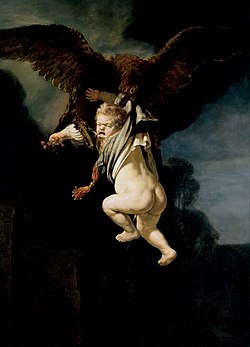The Abduction of Ganymede
 The Abduction of Ganymede | |
| Artist | Rembrandt |
|---|---|
| Year | 1635 |
| Catalogue | Rembrandt Research Project, A Corpus of Rembrandt Paintings VI: #137 |
| Medium | Oil on panel |
| Dimensions | 177 cm × 130 cm (70 in × 51 in) |
| Location | Staatliche Kunstsammlungen Dresden, Dresden |
The Abduction of Ganymede is a 1635 oil painting of Ganymede by the Dutch Golden Age painter Rembrandt in the collection of the Staatliche Kunstsammlungen Dresden.
Painting[]
This painting was documented by Hofstede de Groot in 1915, who wrote: "207. THE RAPE OF GANYMEDE. Sm. 197; Bode 79 ; Dut. 106 ; Wb. 70 ; B-HdG. 197. The eagle of Zeus, seen in front with out-stretched wings, rises towards the heavens. He holds with his beak the clothing, and with his talons the left arm, of the fair curly-haired boy, who, turned sharply to the left and almost seen from the back, faces round to the spectator as if crying loudly, and with his right hand tries to repulse the bird. His light blue dress and shirt are pulled up by the eagle's claws so as to expose the whole of the boy's lower limbs. On the left the corner of a scarf with a tassel flaps in the wind. The boy, who in his fright makes water, holds cherries in his left hand. Bright light falls from the left full on the boy. The sombre background contains on the left at foot some clumps of trees, before which in the foreground are the pinnacles of a building. Full length, life size. Signed at top on the hem of the shirt, "Rembrandt ft. 1635"; oak panel, 68 1/2 inches by 52 inches. A drawing showing a sketch for the picture is in the Dresden Print-room; reproduced by Lippmann, No. 136. Engraved by , by A. Cardon in Reveil, by L. Noel in " The Dresden Gallery." Mentioned by Vosmaer, pp. 154, etc., 507; by Bode, pp. 439, 568; by Dutuit, p. 28 ; by Michel, pp. 221, etc., 553 [170-71, 438]. Sales. Amsterdam, April 26, 1716 (Hoet, i. 191), No. 33 (175 florins). W. van Velthuyzen, Rotterdam, April 15, 1751, No. 46. Bought in the same year at Hamburg through Heinecken for Dresden. In the Dresden Gallery, 1908 catalogue, No. 1558."[1]
Oddly, Hofstede de Groot did not comment on the theme of this painting at all, though Smith before him found it highly unusual when he wrote: "197. The Rape of Ganymede. If the picture (for the present description is taken from a print) be really by Rembrandt, his intention must have been to burlesque the mythological subject above stated, for he has represented the beautiful Ganymede as a great lubberly child, with a blubbering grimace of countenance, sprawling, with extended arms, in the talons and beak of the eagle Jupiter. The bird has seized him by his unclassical raiments, the weight of his fat body has drawn his clothes up to his shoulders, and left his lower extremities in a state of nudity, and is thus bearing him through the murky air to Olympus. Engraved by A. Cardon. 6 ft. 3 in. by 2 ft. 8 in.—C. Now in the Dresden Gallery."[2]
Interpretation[]
Rembrandt's depiction of the reluctant Ganymede should be seen not in the Renaissance context of the homo-erotic catamite theme, but in a relatively new Protestant Baroque interpretation of Ganymede as a beloved child "abducted from life too soon".[3] In the 1670s the painter Nicolaes Maes even made a whole series of paintings of Ganymedes that are considered deathbed portraits of children.

early sketch by Rembrandt in the Kupferstich-Kabinett, Staatliche Kunstsammlungen Dresden

Die Entführung des Ganymed, by Christian Gottfried Schultze, c. 1780

George de Vicq as Ganymede, by Nicolaes Maes, 1681, Fogg Art Museum
An inventory, made on 17 February 1671, of the estate of Catharina van der Pluym, widow of Willem Schilperoort and aunt of Rembrandt's great-nephew and pupil Karel van der Pluym, mentions "een stuck van Ganimedes – f7.- "[4]
See also[]
References[]
- ^ Entry 207 for ''The Rape of Ganymede in Hofstede de Groot, 1915
- ^ 546. The Rape of Ganymede in Smith's catalogue raisonne of 1836
- ^ ...d'ontschakinge van Ganymedes, die uytnemende schoon, zijn Ouders vroegh ontstorf, en daerom ontrooft te zijn (English: The abduction of Ganymedes, who left his parents in early death, is therefore a stolen beauty) in Karel van Mander's Schilder-boeck, 1604, in the DBNL
- ^ De roof van Ganymedes (Ovidius, Metamorfen X, 153ff), 1635, Staatliche Kunstsammlungen Dresden in the RKD
Sources[]
- The Rape of Ganymede in the Rembrandt database
- 1635 paintings
- Oil paintings
- Paintings by Rembrandt
- Collections of the Gemäldegalerie Alte Meister
- Paintings of children
- Birds in art
- Paintings depicting Greek myths
- Ganymede (mythology)


